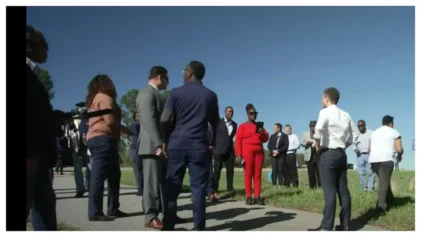For decades, Brazil touted itself as the most racially diverse society in the world, celebrating the idea that there was no racism in Brazil because its society was a melting pot made up of Brazilians with hues across the spectrum. But that idea of Brazil has been torched as the nation in recent years has had to confront the reality that Black and Brown Brazilians remain at the bottom of Brazilian society on every measure.
Brazilian universities have even instituted controversial American-style affirmative action programs to increase the number of Black and Brown young people with access to higher education.
This thinly veiled discrimination against darker skin is not just resigned to Brazil in South America. Other countries with significant populations of citizens with African ancestry, such as Colombia, are also grappling with how to curtail the widespread discrimination against black people.
Renewed attention was focused on the place of African ancestors in Brazilian society with the discovery in 2010—as workers were beautifying a rundown section of the port in Rio de Janeiro to prepare for the 2016 Olympics—of the ruins of Valongo, once the central landing stage for African slaves imported to Brazil. Of the estimated 12 millions Africans who were imported to the Americas as part of the slave trade, just 400,000 to 600,000 Africans were sent to the United States—while 5 million were sent to Brazil. But because Brazilians engaged in more intermarriage and race-mixing, the resulting society that emerged in the wake of slavery’s abolition in 1888 tried to pretend for a long time that racism in Brazil didn’t exist.
The biased thinking in Brazil was brought home by a recent incident, when a handsome European-looking, blue-eyed Brazilian who was homeless because of his drug addiction elicited an outpouring of concern and curiosity—primarily because Brazilians were accustomed to seeing dark-skinned people in such a predicament, not whites.
While 51 percent of Brazilians defined themselves as black or brown in a 2010 census, just 7 percent of the residents in Rio’s richest districts are black and only one member of the 38-person cabinet of female President Dilma Rousseff is black—while the majority of the residents of the favelas (slums) are black.
“Racism in Brazil is well hidden, subtle and unspoken, underestimated by the media,” Joaquim Barbosa, the first black judge to sit on the bench of the supreme court in Brazil, told the Guardian. “It is nevertheless extremely violent.”
Moved by such disparities, Brazil has made moves to implement race-based affirmative action programs in the universities. Since 2001 more than 70 public universities have introduced racial admissions quotas—for example, in Rio de Janeiro’s state universities, 20 percent of places are set aside for black students who pass the entrance exam. Another 25 percent are reserved for a “social quota” of pupils from state schools whose parents’ income is less than twice the minimum wage—who are often black. In addition, a federal program awards grants to black and brown students at private universities.
These measures are starting to make a difference. Although only 6.3% of black 18- to 24-year-olds were in higher education in 2006, that was double the proportion in 2001, according to IPEA. (The figures for whites were 19.2% in 2006, compared with 14.1% in 2001).
“We’re very happy, because in the past five years we’ve placed more blacks in universities than in the previous 500 years,” Frei David Raimundo dos Santos, a Franciscan friar who runs Educafro, a charity that holds university-entrance classes in poor areas, told the Economist. “Today there’s a revolution in Brazil.”
The next frontier is the labor market, where some cities like Rio are toying with affirmative action set-asides in hiring.
If you stand outside the adjacent headquarters of Petrobras, the state oil company, and the National Development Bank in Rio at lunchtime, you will see that “all the managers are white and the cleaners are black,” says Frei David.
Opponents of affirmative action contend that it will ruin the special nature of Brazilian society by making Brazilians think in a more explicit way about their skin color. But its proponents point out that the traditional way of thinking in Brazil is that black people are supposed to be on the bottom rung of society, while light-skinned people are at the top. They say only aggressive intervention will change that.


